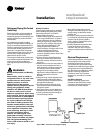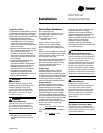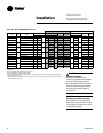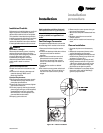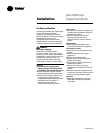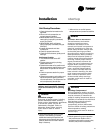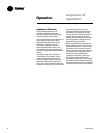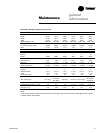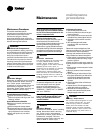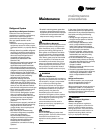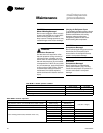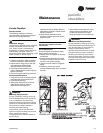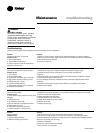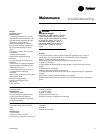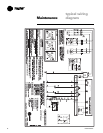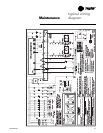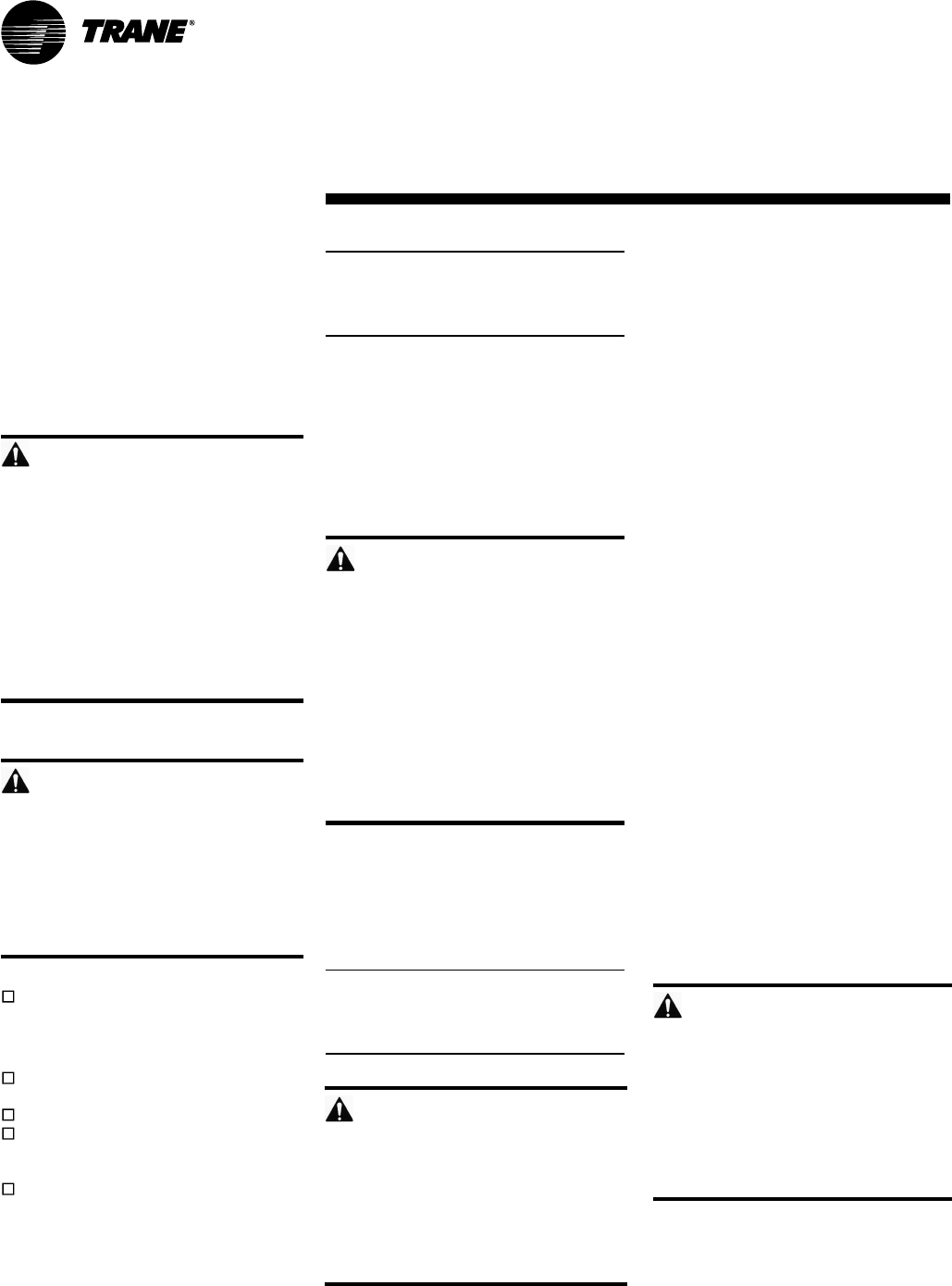
26 PKG-SVX14A-EN
Maintenance
maintenance
procedures
Maintenance Procedures
This section describes specific
maintenance procedures that must be
preformed as a part of the normal
maintenance program. Always
disconnect electrical power to the unit
before performing these procedures and
heed all warnings and cautions.
WARNING
Live Electrical Components!
During installation, testing, servicing,
and troubleshooting this equipment, it
may be necessary to work with live
electrical components. Have a
qualified licensed electrician or other
individual who is properly trained in
handling live electrical components
perform these tasks. Failure to follow
all electrical components could result
in death or serious injury.
WARNING
Hazardous Voltage!
Disconnect all electrical power including
remote disconnects before servicing
unit. Follow proper lockout/tagout
procedures to ensure power cannot be
inadvertently energized. Failure to
disconnect power before servicing can
result in death or serious injury.
Periodic Maintenance Checklist
Inspect coil surface for cleanliness.
Clean as required, referring to the “Coil
Cleaning” section.
Annual Maintenance Checklist
Perform all monthly maintenance
inspections.
Perform seasonal startup checks.
Leak test refrigerant circuits. Inspect
contacts of fan motor contactors and
relays. Replace all worn contacts.
Clean and repaint any corroded
surface.
Note: the following coil cleaning proce-
dures apply only to the outdoor condens-
ers. Do not use these procedures for the
reheat or evaporator coils.
Cleaning the Condenser Coils
Clean the coil at least once each year or
more frequently if located in a dirty
environment, to help maintain proper unit
operating efficiency. High discharge
pressures are a good indication that the
coil needs cleaning. Follow the detergent
manufacturer instructions as closely as
possible to avoid potential coil damage.
WARNING
Hazardous Chemicals!
Coil cleaning agents can be either acidic
or highly alkaline.Handle chemical
carefully. Proper handling should
include goggles or face shield, chemical
resistant gloves, boots, apron, or
protective suit as required. For personal
safety, refer to the cleaning agent
manufacturer’s materials safety data
sheet and follow all recommended safe
handling practices. Failure to follow all
safety instructions could result in death
or serious injury.
To clean the refrigerant coil, use a soft
brush and sprayer, such as a garden
pump up or high pressure type . In
addition, use a quality detergent; like
“SPREX AC’, “ OAKITE 161” or “OAKITE
166” and “COILOX.”
Note: If detergent is strongly alkaline (i.e.
has a pH value greater that 8.5 ) after
mixing, you must add an aluminum
corrosion inhibitor.
Coil Cleaning Procedure
1. Disconnect power to the unit.
2. Remove panels from the unit to gain
access to the coil.
3. Use a soft brush to remove loose dirt
and debris form both sides of the coil.
4. Straighten coil fins with fin comb as
required.
5. Mix the detergent with water
according to the manufacturers
instructions.
Observe all recommendations of the
cleanser manufacturer. The coil cleanser
manufacturer’s recommendations,
warnings and cautions will at all times
take precedence to these instructions.
1. Place solution in the sprayer. Be sure to
follow these guidelines if using a high-
pressure sprayer:
a) Keep minimum nozzle spray angle 15°.
b) Spray solution at a 90° angle to the coil
face.
c) Keep sprayer nozzle at least six inches
from the coil.
d) Sprayer pressure must not exceed
600 psi.
2. Spray leaving air side of the coil first
then spray the entering air side of the
coil. Allow the detergent and water
solution to stand on the coil for five
minutes.
3. Rinse both sides of the coil with cool,
clean water.
4. Inspect the coil. If it still appears dirty,
repeat the cleaning procedure.
5. Reinstall all unit components and
panels, and restore electrical power
and gas supply to the unit.
CAUTION
Freezing Temperatures!
Do not allow liquid refrigerant to come
into contact with the skin. If it does,
treat the injury similar to frostbite.
Slowly warm the ffected area with
lukewarm water and seek immediate
medical attention. Direct contact with
liquid refrigerant may cause minor or
moderate injury.
WARNING
Hazardous Voltage!
Disconnect all electrical power including
remote disconnects before servicing
unit. Follow proper lockout/tagout
procedures to ensure power cannot be
inadvertently energized. Failure to
disconnect power before servicing can
result in death or serious injury.



